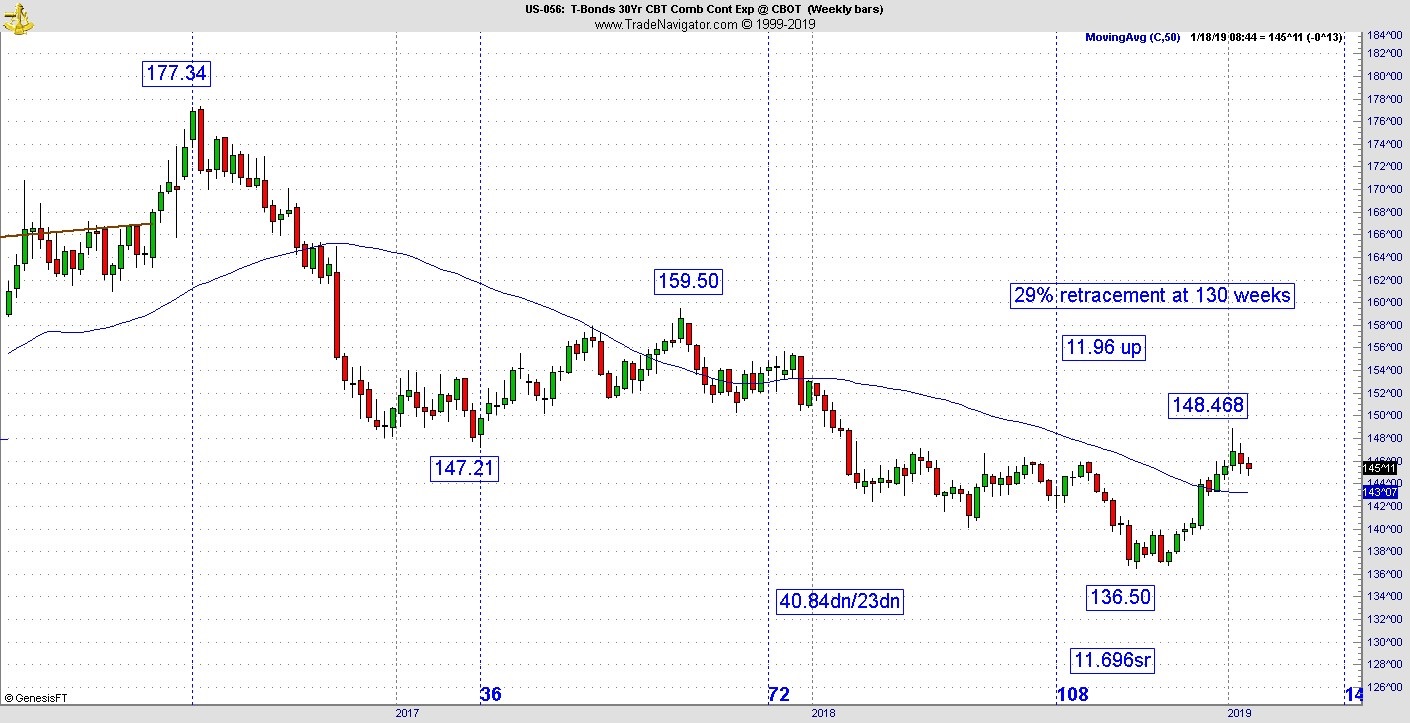Just because everyone is saying the economy is about to implode, doesn’t mean it won’t. Jeff Greenblatt, Director Lucas Wave International, looks at debt; it’s not a pretty picture.
Last week I mentioned a potential intermediate- to longer-term vibrational change for the bond market; now we are starting to see some follow through. It’s not enough to induce insomnia just yet, but if this seedling grows strong roots, we might be having more serious discussions about interest rates in the not too distant future.
Before I get to the bond market, how are some of the other intermediate to longer term vibrations I’ve covered here working out? Crude oil rallied 25.84% from the low the day before Christmas to the recent high. Now its consolidating. The Aussie Dollar is up 6.1% from its Jan. 2 low, and is now consolidating.
Even as the stock market stays in rally mode and the Fed may turn dovish this year, longer term rates have been in a new bear market since July 2016. My Kairos vibrational/square out work is best viewed in terms of bond prices, and we know interest rates move inversely to pricing. We can see the long bond reversed course on a 29% retracement at 130 weeks off the high (see chart below). The pattern is now working on the second consecutive bearish week. Let’s talk about why this might present a much bigger problem than most people are willing to admit.

I’ve looked around the web and have found a few sites that use the Bank for International Settlements (BIS) as their main source. One of these is the Daily Reckoning. Yeah, I know how some of you feel about Rickards, we know him as the one who has been sounding the alarm for years. I feel the same way about the Armageddon crowd. He was right in 2008. Total global debt is roughly $233 trillion. The global debt to GDP ratio is 318% which is very high and becomes dangerous in a rising rate environment. The BIS numbers have the amount of bank derivatives at $750 trillion. Adding debt and derivatives together that number is around $1 quadrillion. Daniel Estulin has added his own research and some of his work is like a modern version of the Jekyll Island book (first edition 1994) and says the figure is close to $2 trillion when unfunded liabilities are added to the mix. Whichever number is used, it is far greater than the obligations that came due in 2008.
That means if the bear phase that started in 2018 gets another leg down, 2019 may well cause an implosion in the financial system exponentially greater than the one from only 10 years ago. Is it going to happen? For that answer we need to keep a watchful eye on the bond market. The Fed only controls short term rates. They don’t have the same exploding balloon payments that set up the 2008 crash, but if rates accelerate at a rate that can’t be absorbed by the economy, in the very least, the housing and auto markets will come to a grinding halt.
The other problem folks have been agonizing over for several years is student loan debt. According to a Forbes article from June 13, 2018 there are more than 44 million borrowers who owe $1.5 trillion collectively. This figure is higher than both credit card and auto loan debt. Students saddled with debt have a very hard time buying homes. That means a whole generation of young earners won’t buy homes. Do you think the student loan problem and the possibilities for the housing market can be related?
According to ABC News in Tampa Bay, the Florida Board of Health has started suspending health care licenses of healthcare workers that have defaulted on their student loans. There was a clarification to this story, which ran two days ago but the fact is approximately 100 health care workers have lost their license to practice in Florida because they can’t repay their student loans. The Federal student loan companies have been lobbying states for years to punish those who default and Florida is the only state enforcing those laws. These licenses include nurses, pharmacists and opticians. The obvious problem is if folks can’t pay their obligations with a job, how are they going to have a chance if they lose their ability to derive a professional income?
Long term readers to this space know I don’t normally go this route. The experts have been warning about credit bubbles for years yet most of us pay no attention to them. The ability to service debt obligations works just fine while the crowd is in a rising social mood and the stock market stays bullish. It’s when markets rollover we need to be concerned. Estulin states Deutsche Bank in Germany has a gross derivative exposure of $42 trillion in U.S. dollars. The Fed has $56 billion in cash and $21 trillion in debt which is a ratio of 77-1. In Italy 114 out of 500 banks are bankrupt. Last time we were in this position the markets topped in 2007, but took a full year for the crisis to erupt. That was in a period of relative political stability. Now we are dealing with the kind of politics where ideology is king and throws economics under the bus. It’s a vicious cycle.
Right now, the stock market is in rally mode and appears steady. I’m not in the doom and gloom crowd, but given the state of the global debt situation, why get long-term bullish again? The Cboe Volatility Index (VIX) is way down near complacency, it’s a problem given the stock market has barely made it back to the middle of the range. Never forget that in a bear market, surprises come to the downside.




















